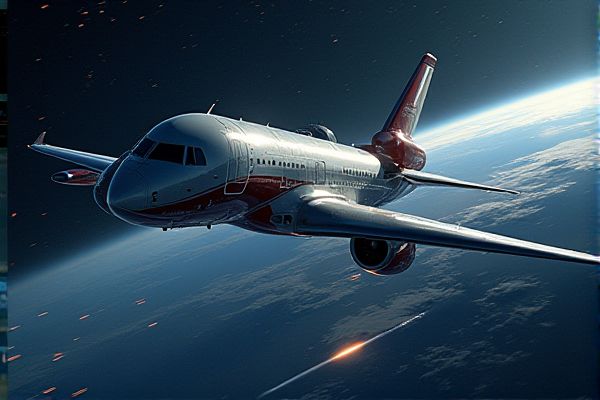
AI enhances aerospace design through advanced simulations that optimize aerodynamics and fuel efficiency, reducing development costs and time. Predictive maintenance utilizes AI to analyze data from aircraft sensors, identifying potential failures before they occur, which improves safety and reduces downtime. AI-driven systems support air traffic management, improving flight scheduling and reducing delays by processing vast amounts of data in real-time. Autonomous drones and aircraft leverage AI for navigation and obstacle avoidance, paving the way for innovative applications in cargo delivery and surveillance.
AI usage in aerospace
Predictive Maintenance Systems
AI usage in aerospace can improve efficiency and safety through predictive maintenance systems. These systems analyze data from aircraft sensors to predict potential failures before they occur, reducing downtime and maintenance costs. For example, airlines like Delta Airlines utilize these technologies to enhance operational reliability. The possibility of extending aircraft lifespan and reducing unexpected repairs presents a significant advantage for the industry.
Autonomous Flight Controls
AI applications in aerospace, particularly in autonomous flight controls, present significant opportunities for enhancing safety and efficiency. The integration of AI algorithms can optimize flight paths in real-time, reducing fuel consumption and travel time. Companies like Boeing are leveraging these technologies to advance their aircraft systems and improve operational performance. This increases the likelihood of minimizing human error during critical flight phases, potentially leading to safer air travel.
Computational Fluid Dynamics Optimization
AI can significantly enhance Computational Fluid Dynamics (CFD) optimization in aerospace by improving simulation accuracy and reducing computation time. For instance, aerospace companies like Boeing are increasingly adopting AI algorithms to refine aerodynamic designs. This integration allows for quicker iterations, which can lead to improved performance and fuel efficiency in aircraft. The potential for reduced development costs and improved safety features presents a strong advantage for the industry.
Satellite Image Analysis
AI usage in aerospace shows potential for improving satellite image analysis. By applying machine learning algorithms, operational efficiency can be enhanced, allowing for more accurate data interpretation. For instance, NASA has explored AI technologies to analyze satellite imagery for environmental monitoring. This integration may lead to faster decision-making and better resource management in various aerospace projects.
Air Traffic Management Enhancements
The integration of AI in air traffic management can significantly improve safety and efficiency. Advanced algorithms may optimize flight paths, reducing congestion and minimizing delays. For example, NASA's Air Traffic Management system showcases how AI can enhance real-time decision-making. Implementing these technologies could lead to cost savings and better resource allocation for airlines.
Smart Manufacturing Processes
AI can enhance safety and efficiency in aerospace by predicting equipment failures before they occur, reducing downtime. In smart manufacturing processes, integration of AI allows for real-time data analysis, improving production accuracy. Companies like Boeing have started leveraging AI for better design optimization, showcasing its potential benefits. The chance of minimizing waste and increasing productivity is higher with AI-driven processes.
Fuel Efficiency Optimization
AI in aerospace can enhance fuel efficiency optimization by analyzing vast datasets to predict fuel consumption patterns. Companies like Boeing are already exploring machine learning algorithms to improve flight trajectories and reduce overall fuel usage. This technology can lead to significant cost savings and lower emissions for airlines. Moreover, as AI continues to evolve, its application could expand further, providing even more innovative solutions to fuel management challenges.
Real-time Data Analysis and Monitoring
AI enhances real-time data analysis in aerospace, allowing for improved decision-making during flight operations. For example, predictive maintenance algorithms can analyze sensor data from aircraft to predict potential failures before they occur. This capability can lead to reduced downtime and lower maintenance costs for institutions like NASA. The overall efficiency of air traffic management can also be optimized, further benefiting the industry.
AI-driven Design and Prototyping
AI-driven design and prototyping in aerospace can enhance the efficiency and accuracy of aircraft development. By utilizing machine learning algorithms, companies like Boeing can analyze vast datasets to optimize design parameters and reduce material waste. The application of AI can lead to faster iteration cycles, enabling engineers to prototype more effectively and respond to design challenges promptly. This integration of AI technology presents opportunities for innovation, potentially leading to improved performance and reduced costs in aerospace projects.
Spacecraft AI Systems
AI in aerospace enhances efficiency in spacecraft systems by automating various operational tasks. For instance, autonomous navigation algorithms can improve the accuracy of space missions, potentially reducing fuel consumption. Predictive maintenance powered by AI can also foresee equipment failures, minimizing downtime and repair costs. These advancements may lead to safer and more reliable missions, which can ultimately benefit institutions like NASA in their exploratory endeavors.
 techknowy.com
techknowy.com